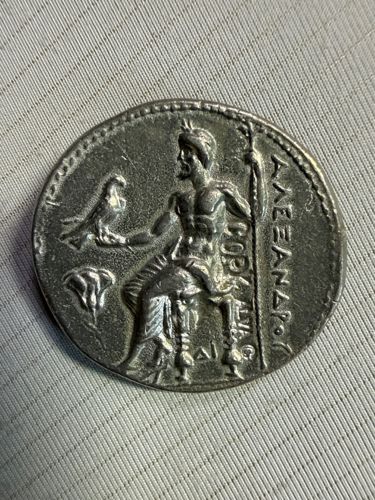Tetradrachm of Alexander the Great
Country of Origin: Macedonian Kingdom (Ancient Greece)
Year of Issue: Circa 336-323 BCE (posthumous issues continued after his death)
Denomination: Tetradrachm
Composition: Silver

Brief Description
The obverse (not shown in image) typically features a head of Heracles (wearing a lion-skin headdress). The reverse, as shown, depicts Zeus Aetophoros enthroned to the left, holding an eagle in his outstretched right hand and a scepter in his left hand. The legend 'ΑΛΕΞΑΝΔΡΟΥ' (ALEXANDROU) is inscribed vertically to the right of Zeus. Further symbols or monograms may be present in the field below the eagle or under the throne, specific to the mint and magistrate.
Historical Significance
Alexander the Great's tetradrachms were among the most widely circulated coins in the ancient world, playing a crucial role in trade across his vast empire. They symbolized his authority and the expansion of Hellenistic culture. Posthumous issues continued for decades after his death, maintaining his legacy and providing a stable currency.
Estimated Value
Varies significantly depending on condition, rarity of specific mint marks, and historical context. Can range from a few hundred dollars for common, well-worn examples to tens of thousands or even more for rare, high-grade specimens. This particular coin appears to be a replica or heavily worn, which would significantly reduce its value.
Care Instructions
Store in a cool, dry place, ideally in an inert holder (e.g., Mylar flip or slab). Handle by the edges to avoid transferring oils from your skin. Do not attempt to clean the coin, as cleaning can permanently damage its surface and significantly diminish its value to collectors.
Created At: 2025-11-08T19:12:58.223547